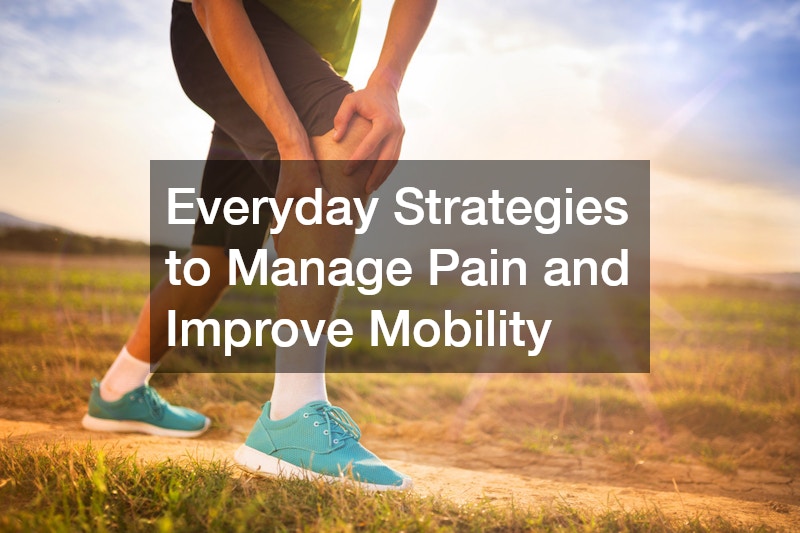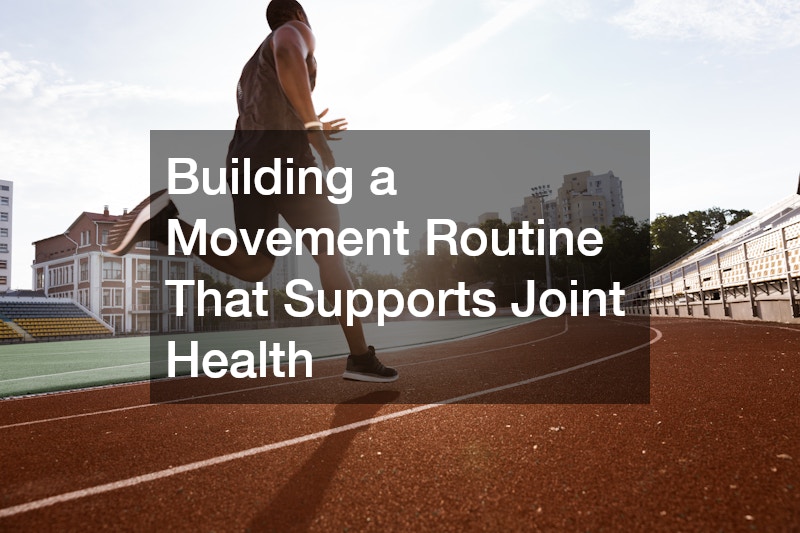Chronic discomfort and limited mobility can gradually erode quality of life. What begins as a mild nuisance—tightness in the back, stiffness in the hips, or fatigue from simple tasks—can slowly evolve into a daily challenge that affects mood, movement, and independence. The good news is that pain management and mobility improvement do not depend solely on major medical interventions. Many daily steps, routines, and mindful decisions can help reduce discomfort and allow your body to move more freely.
This guide explores evidence-informed strategies that anyone can start today. It blends practical lifestyle adjustments, targeted exercises, habit-building techniques, and advice on when to seek help. Whether you’re managing long-term discomfort or simply looking to prevent mobility issues as you age, these strategies offer a comprehensive path toward feeling better and maintaining an active, capable body.
Recognizing Early Signals and Taking Action
Pain rarely appears out of nowhere. Most of the time, the body sends subtle signals before discomfort becomes a bigger problem. Learning to recognize these early cues allows you to take corrective action before pain interferes with daily activities.
One common example is shoulder pain, which often begins as a mild twinge during overhead movements or minor stiffness when reaching behind you. Instead of ignoring these early signs—something many people do—you can use them as a prompt to evaluate your daily movement patterns.
How to Identify Early Warning Signs
-
A sensation of warmth or pressure in a joint after repetitive movement
-
Difficulty maintaining a full range of motion first thing in the morning
-
Discomfort after prolonged sitting, even if mild
-
Recurring stiffness after activity, rather than during it
-
A feeling of weakness or instability in a limb
Why Early Action Matters
When addressed promptly, many forms of discomfort respond quickly to simple adjustments such as rest, posture correction, or moderate strengthening. If ignored, however, the body compensates in ways that can create new problems. A small hip restriction, for example, may lead to added pressure on the lower back.
If mild recurring pain persists for more than a week or begins interfering with your ability to move naturally, consulting a local physician can help you identify the source. An early evaluation often prevents chronic issues from forming.
Practical First Steps to Take
-
Reduce aggravating movements temporarily
-
Apply alternating warmth and coolness to the area
-
Note what activities seem linked to discomfort
-
Keep a short diary documenting when symptoms appear
-
Begin gentle mobility exercises once the initial irritation decreases
Building a Movement Routine That Supports Joint Health
Movement is one of the most powerful tools for reducing discomfort and improving mobility. The key is consistency—especially with activities that encourage joint lubrication, circulation, and muscular balance. Group activities such as fitness classes can help people stick to a routine by providing structure and motivation.
Selecting Movement Practices That Fit Your Needs
Not all exercise is suitable for all bodies. When building your personal routine, consider movements that:
-
Strengthen without strain
-
Improve stability and balance
-
Encourage a full range of motion
-
Include both slow and dynamic actions
Activities like adult dance classes combine gentle aerobic conditioning with coordination, rhythm, and flexibility. Many people find that these sessions feel less like exercise and more like joyful movement, making them easier to maintain over the long term.
Creating a Weekly Mobility-Supporting Schedule
A balanced routine may look like:
-
2–3 days of guided group activity (e.g., light cardio or low-impact classes)
-
2 days of short strength sessions
-
Daily mobility warm-up lasting 5–10 minutes
-
Active breaks every hour for those with sedentary jobs
Tips for Maximizing Movement Benefits
-
Start slowly and allow your body to adapt
-
Choose instructors who understand modifications
-
Prioritize form over intensity
-
Build variety into your routine to prevent plateaus
-
Celebrate small improvements, such as increased flexibility or reduced stiffness
Using Targeted Therapies for Faster Relief
While daily habits and intentional movement form the foundation of pain management, targeted therapies can accelerate recovery and help manage difficult flare-ups. Non-invasive options such as cold laser therapy offer relief by directing light into tissues to reduce inflammation and support healing.
When Targeted Therapies Are Useful
These options may help when:
-
Discomfort is related to chronic inflammation
-
You have localized tenderness or swelling
-
Mobility is limited by soft tissue tightness
-
Self-care routines aren’t providing sufficient improvement
What to Expect From Different Modalities
Cold laser therapy is often used for:
-
Joint inflammation
-
Muscle sprains
-
Soft tissue injuries
-
Localized chronic pain
It is typically quick, painless, and requires no downtime.
Microneedling, though more commonly known for cosmetic use, may also support healing by:
-
Stimulating collagen in superficial tissues
-
Increasing circulation
-
Supporting recovery from small scars or skin injuries that restrict mobility
Checklist for Evaluating Whether to Try a Therapy
-
Have you experienced persistent discomfort for more than a month?
-
Does the discomfort limit specific movements?
-
Are you unable to perform normal daily activities without modification?
-
Have you already tried stretching, strengthening, and postural corrections?
Safety and Suitability
Always seek treatment from trained professionals. Discuss any underlying conditions, medications, or concerns before beginning. Start with a short trial period before committing to a long series of sessions.
Incorporating Lifestyle Habits That Reduce Daily Discomfort
Lifestyle habits influence pain more than many people realize. Small daily decisions affect inflammation, circulation, joint pressure, and overall energy. While each individual’s body is different, certain principles apply broadly.
Reducing Load on Joints
Even modest reductions in body weight can significantly reduce stress on the knees, hips, and spine. For those who need guidance in making sustainable long-term changes, support from a weight loss center can provide structure and monitoring. Sustainable weight management strategies that reduce pain include:
-
Eating anti-inflammatory foods
-
Tracking meals without obsessing
-
Choosing enjoyable physical activities
-
Improving hydration habits
Home-Based Support for Daily Comfort
For individuals who need help maintaining consistent routines, a personal care agency can offer:
-
Assistance with mobility-promoting activities
-
Help with stretching or exercises
-
Guidance for setting up ergonomic home environments
-
Support in medication reminders or daily wellness habits
Building Daily Micro-Habits to Reduce Pain
Building small, consistent habits throughout the day can make a significant difference in reducing discomfort. A simple posture reset each hour—lifting the chest, relaxing the shoulders, and aligning the pelvis—helps counteract the effects of prolonged sitting or standing. Staying hydrated by drinking small amounts of water frequently supports joint function and overall energy. Periodic breathing check-ins, using slow and deep breaths, help calm the nervous system and reduce tension. Incorporating movement breaks every 30 to 60 minutes, whether through gentle walking or light stretching, keeps your joints mobile and prevents stiffness from setting in.
Evening Routine for Recovery
A simple nightly routine can reduce next-morning stiffness:
-
Warm shower to relax muscles
-
Gentle floor stretches
-
Journaling about any triggers or improvements
-
A short gratitude practice to reduce stress-related pain patterns
Navigating Medical Options When Pain Spikes
Even with consistent self-care, pain can occasionally escalate quickly. Knowing when to seek professional help is crucial. Sometimes discomfort that seems muscular is actually related to blood flow issues, making timely evaluation essential.
Recognizing When Circulation Plays a Role
Symptoms that might indicate circulation-related discomfort include:
-
Heaviness in the legs
-
Throbbing sensations during rest
-
Persistent swelling
-
Darkening or discoloration of the skin
-
Visible swelling of superficial veins
If symptoms point toward circulation issues, a vein doctor can evaluate blood flow, rule out complications, and recommend appropriate treatment.
When Immediate Care Is Needed
Severe pain or sudden functional limitations should never be ignored. Consider seeking same-day attention if you experience:
-
Sudden, sharp, or shooting pain
-
Inability to bear weight
-
Rapid swelling
-
Loss of movement
-
Numbness or tingling spreading to multiple areas
In these cases, visiting urgent care might be the safest choice. Prompt treatment can prevent long-term complications and ensure you receive imaging or testing if necessary.
Preparing for a Medical Visit
Bring:
-
A list of symptoms and when they began
-
Notes on what makes the pain worse or better
-
A record of any previous injuries to the area
-
A list of medications or supplements
-
Any recent activity changes that might have contributed
Questions to Ask
When meeting with a medical professional, it helps to come prepared with thoughtful questions that clarify your situation and guide your next steps. Ask what might be causing your pain and which movements you should temporarily avoid to prevent aggravation. It’s also useful to confirm which exercises are safe to perform so you can continue supporting your mobility without risking further injury. In some cases, imaging may be necessary, so inquire whether it’s recommended for your symptoms. Finally, make sure you understand what warning signs should prompt a follow-up or return visit, ensuring you stay proactive about your recovery.
Strengthening Key Muscle Groups to Support Mobility
Muscle weakness is one of the most common contributors to pain. Strengthening doesn’t require heavy weights or a gym membership—just consistency and proper form. When your muscles are strong and stable, they protect your joints and reduce fatigue.
Why Strength Matters
Weak muscles place undue pressure on joints, forcing them to carry loads they weren’t meant to handle. This leads to faster wear and tear, inflammation, and compensation patterns.
Core Muscle Groups to Focus On
-
Hip stabilizers for walking and standing
-
Glutes for lifting and posture
-
Abdominals for spinal support
-
Upper back muscles for better alignment
-
Calf muscles to assist circulation
Tips for Progression
To continue improving strength safely, focus on gradual progression. Increase your repetitions slowly over time so your muscles can adapt without becoming overworked. As movements begin to feel easier, try holding them a bit longer to build endurance and stability. Throughout each exercise, maintain steady, controlled breathing to support proper form and reduce unnecessary tension. Most importantly, pay attention to your body’s signals—challenge yourself, but stop immediately if discomfort shifts from normal exertion to sharp or sudden pain.
Improving Mobility Through Daily Movement Patterns
Mobility isn’t only about exercise—it’s also about how you sit, stand, and move throughout everyday life. Improving everyday movement patterns can dramatically reduce discomfort.
Ergonomic Adjustments
-
Keep screens at eye level
-
Choose chairs that support the natural curve of the spine
-
Keep feet flat and supported
-
Avoid crossing legs for long periods
Movement Snacks
Every hour or so:
-
Stand up and stretch your arms overhead
-
Rotate your neck gently side to side
-
Perform ankle circles
-
Take a short walk or march in place
Morning, Midday, and Evening Mobility Routines
Morning:
-
Gentle spinal rotations
-
Ankle rolls
-
Light stretching to wake up the joints
Midday:
-
Hip-opening stretches
-
Shoulder mobility drills
-
Marching in place to encourage blood flow
Evening:
-
Slow, deep stretching of the legs and back
-
Controlled breathing exercises
-
Relaxing the jaw and neck muscles
Supporting Your Mobility Through Mind-Body Practices
Chronic discomfort is not just physical. Stress, tension, and emotional patterns influence how pain is perceived. Mind-body practices help calm the nervous system and reduce muscular guarding.
Breathing Techniques
Try:
-
Box breathing (inhale 4, hold 4, exhale 4, hold 4)
-
Diaphragmatic breathing to loosen the back and ribs
-
Long exhalation breaths to induce calm
Gentle Mind-Body Movements
-
Slow yoga sequences
-
Tai chi
-
Mobility flow routines
-
Guided stretching videos
Reducing Stress-Related Tension
Long-term stress often shows up in the body as muscle tension, fatigue, or heightened sensitivity to pain, making stress management an important part of maintaining mobility. Incorporating calming practices such as journaling or mindfulness meditation can help quiet the mind and reduce the physical strain stress creates. Progressive muscle relaxation is another useful technique, guiding you to intentionally release tension throughout the body. Equally important is setting clear boundaries in your daily life to prevent emotional overload, which can otherwise contribute to ongoing physical discomfort.
Improving Emotional Resilience
Pain can be discouraging. Practices that help include:
-
Gratitude exercises
-
Regular gentle movement
-
Encouraging social support
-
Maintaining small, achievable goals
Creating a Long-Term Pain Management Plan
Once pain becomes manageable, the next step is maintaining progress. A long-term plan keeps you on track and prevents setbacks.
Track Your Progress
Keep a simple log noting:
-
Pain levels throughout the day
-
Activities that improved mobility
-
Movements that caused discomfort
-
Sleep quality
-
Energy levels
Coordinate Professional Support
You may benefit from a combination of:
-
Periodic check-ins with healthcare providers
-
Strength and mobility coaching
-
Wellness services tailored to your needs
-
Occasional reassessment as your body changes
Adjust Your Lifestyle Over Time
Pain and mobility change with age, activity level, and life transitions. Revisit and adjust your plan quarterly to ensure it meets your current needs.
Maintain Consistency
Maintaining consistency is essential for long-term mobility and pain management. Even during busy periods, aim to prioritize some form of movement each day, keeping your exercises simple and manageable so they feel realistic rather than overwhelming. Lean on supportive routines—such as short mobility breaks or gentle stretching—during stressful times when your body needs them most. And remember to acknowledge your progress along the way; celebrating both small and significant victories helps reinforce positive habits and keeps you motivated over the long term.
Improving mobility and managing pain is an ongoing process, not a one-time solution. With consistent attention to daily habits, mindful movement, and a willingness to seek support when necessary, most people can significantly improve how their body feels and functions. Start with small changes, honor your body’s limits, and build a routine that supports your long-term wellbeing. The more intentional you become about how you move and care for yourself, the more freedom, comfort, and confidence you’ll regain in everyday life.







